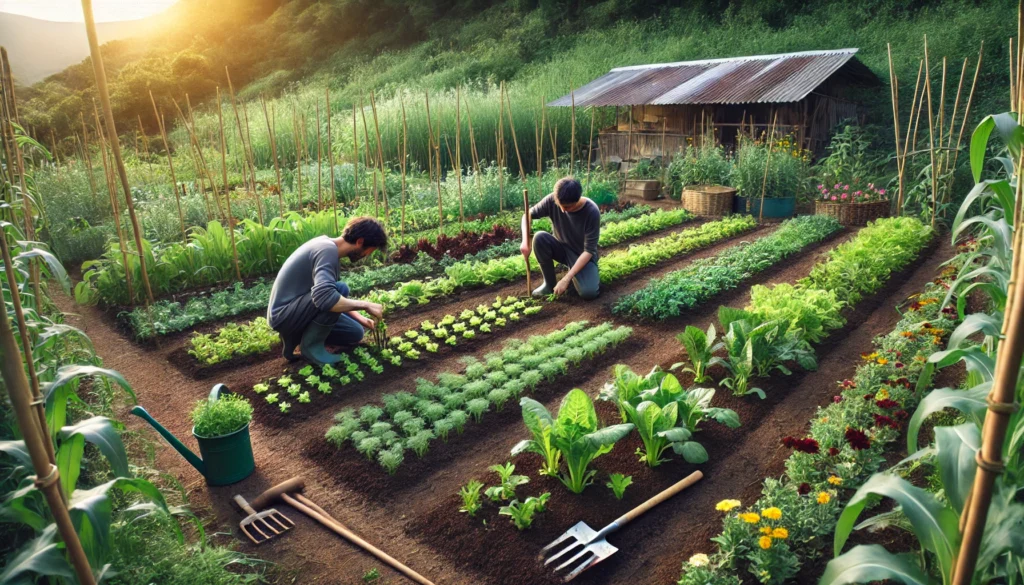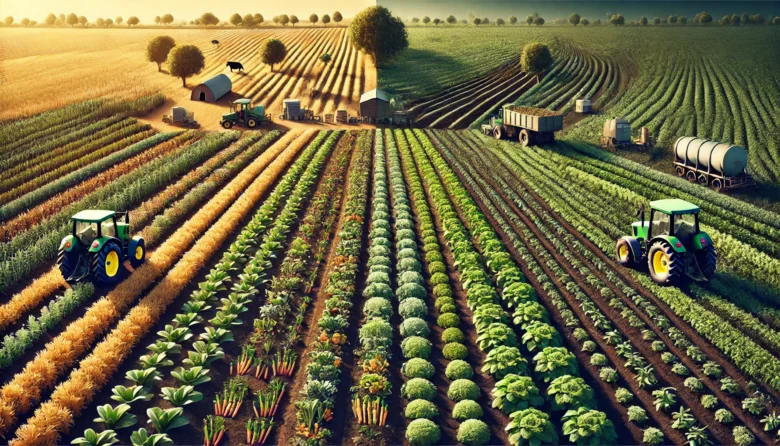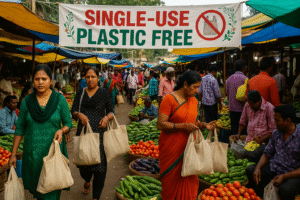Did you know that organic farming can sometimes lead to higher yields in drought conditions compared to conventional farming?
The decision between organic and conventional farming typically revolves around factors like health advantages, environmental effects, and individual preferences. But have you ever wondered about the economic side of this debate? How do the costs, profits, and market dynamics differ between these two approaches? In this blog, we will dive into the economics of organic versus conventional farming, making it easy to understand why farmers—and consumers—are faced with complex decisions.
Understanding the Basics
At the heart of the organic versus conventional farming debate lies the difference in farming practices. Organic farming steers clear of synthetic chemicals such as pesticides and fertilizers, as well as genetically modified organisms (GMOs), opting for natural techniques like crop rotation, composting, and biological pest management. Conventional farming, on the other hand, uses modern techniques like chemical fertilizers, synthetic pesticides, and GMOs to increase crop productivity.
So, what does this mean for the economics of farming?
Cost of Production: Organic vs. Conventional
Organic farming may sound like an eco-friendly dream, but it comes with higher production costs. Farmers who opt for organic methods often face increased labour costs because organic farming requires more manual work. For instance, weeding in an organic farm is done by hand or through mechanical methods, which can be time-consuming and expensive.
Another significant cost for organic farmers is organic certification. In India, organizations like the National Program for Organic Production (NPOP) set strict standards for farms to be certified organic. While this certification ensures consumer trust, it also adds a financial burden to farmers who must pay for inspections and adhere to rigorous standards.
Conventional farming, in contrast, benefits from economies of scale. Large-scale farms can spread their costs across more significant amounts of produce, making the per-unit cost of crops cheaper. The use of chemical fertilizers and pesticides also helps to minimize labour costs and improve yields, further reducing the overall cost of production.

Example: A Small Organic Farmer in Kerala
Take, for instance, a small organic farmer in Kerala who grows coffee. This farmer faces higher labour costs since organic coffee cultivation requires more intensive manual labour to manage pests and weeds. Additionally, the farmer must deal with the certification costs to sell the coffee under the organic label. In contrast, a conventional coffee farmer can use pesticides and herbicides to reduce manual labour, making the overall process more cost-efficient.
Yield Differences: Higher Prices, Lower Output?
A common misconception about organic farming is that it can produce yields equivalent to those of conventional farming. In reality, organic farms tend to have lower yields due to their reliance on natural pest control methods and less intensive farming techniques. Studies suggest that organic farming can produce anywhere from 10% to 20% lower yields compared to conventional methods.
However, organic farmers offset this yield gap by charging higher prices for their products. Organic produce typically sells at a premium in markets due to its perceived health benefits and environmental sustainability. The Organic Trade Association (OTA) in the US reported that organic products often fetch 25% to 30% higher prices than their conventional counterparts.
But is that price premium enough to cover the extra costs?
Market Demand and Consumer Preferences
Both in India and globally, the demand for organic products has been consistently increasing. In India, the organic food industry is expected to grow at a compound annual growth rate (CAGR) of over 20% by 2026. Many consumers are ready to pay a premium for organic items due to their perceived health benefits and eco-friendly nature.
On the flip side, conventional farming caters to a broader market. Since the cost of conventional products is lower, more consumers can afford them. This mass-market appeal means that conventional farms can sell higher volumes, even if their profit margins per unit are lower.
Example: Patanjali’s Organic Line
Patanjali, an Indian company known for its natural and organic products, capitalized on the growing demand for organic food in India. Patanjali’s organic line of products, which includes everything from grains to oils, has seen increased sales thanks to the company’s reputation for offering “pure” and “natural” goods. The company benefits from the trust Indian consumers place in traditional and organic products, though their prices remain higher than conventional alternatives.
Profitability: Which Is More Profitable for Farmers?
The profitability of organic farming varies widely depending on the type of crop, location, and market access. In many cases, organic farmers can make a higher profit per acre due to the premium prices they charge. However, this is only possible if they have access to markets that are willing to pay those premiums.
In contrast, conventional farmers may make a lower profit per unit but can sell in higher volumes. For staple crops like wheat, rice, and maize, conventional farming tends to be more profitable because of the sheer scale at which it can be practised. Additionally, conventional farmers often benefit from government subsidies and better access to farming technology, which helps them cut costs and improve efficiency.
Environmental Costs and Long-Term Sustainability
While the focus here is on economics, it’s important to consider the environmental costs, which can indirectly affect the economy in the long term. Organic farming is generally more sustainable because it avoids chemical inputs that can harm the soil, water, and surrounding ecosystems. In the long term, healthier soils may lead to more stable yields and reduce the need for costly inputs like fertilizers.
On the other hand, conventional farming’s reliance on chemical inputs can lead to environmental degradation, including soil erosion, water pollution, and loss of biodiversity. These environmental costs, while not immediate, can have significant economic consequences, such as the need for restoration efforts or health costs due to polluted water supplies.
The Future of Organic and Conventional Farming
As consumers become more conscious of what they eat and how it’s produced, the demand for organic farming is likely to continue growing. Governments around the world are also increasingly supporting organic farming through subsidies and grants. For instance, the Indian government’s Paramparagat Krishi Vikas Yojana (PKVY) promotes organic farming practices across the country, offering financial assistance to farmers willing to transition to organic methods.
However, conventional farming will not go anywhere soon. Its ability to produce large quantities of food efficiently is crucial for feeding a growing global population. Innovations in technology, such as precision agriculture and genetically modified crops, are also making conventional farming more sustainable and efficient.
Conclusion
The economics of organic versus conventional farming is complex, with no clear winner. While organic farming offers environmental benefits and the potential for higher profits through premium pricing, it comes with higher costs and lower yields. Conventional farming, on the other hand, provides food security and lower costs but may lead to long-term environmental degradation.
For consumers, the choice between organic and conventional comes down to personal values—whether you prioritize sustainability, cost, or availability. For farmers, it’s about finding the balance between profitability and sustainability, considering both short-term and long-term impacts.
As a society, we need to consider how to support both farming methods to ensure a healthy, sustainable, and affordable food system for all.
Author’s Note:
I wrote this blog to highlight the economic challenges and opportunities farmers face when choosing between organic and conventional methods. It’s essential to support sustainable practices while ensuring food remains accessible to everyone.
G.C., Ecosociosphere contributor.
References and Further Reading:
- Sustainable agriculture practices – Uyir Organic. http://uyirorganic.farm/david-vs-goliath-can-organic-farming-feed-the-world/
- Green Revolution – Edupedia Publications Pvt Ltd. https://www.edupub.org/2023/11/green-revolution.html
- Plokhikh, R., Plokhikh, R., Shokparova, D., Fodor, G., Berghauer, S., Tóth, A., Suymukhanov, U., Zhakupova, A., Varga, I., Zhu, K., Zhu, K., & Zhu, K. (2023). Towards Sustainable Pasture Agrolandscapes: A Landscape-Ecological-Indicative Approach to Environmental Audits and Impact Assessments. Sustainability, 15(8), 6913.
- Unveiling the Potential of Aquaponics for Food Production – News Bit Box. https://newsbitbox.com/unveiling-the-potential-of-aquaponics-for-food-production/





Comments
Usually I do not read article on blogs however I would like to say that this writeup very compelled me to take a look at and do it Your writing style has been amazed me Thank you very nice article